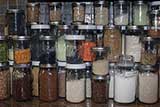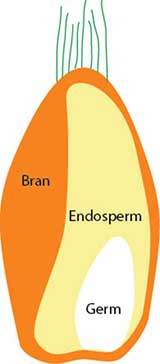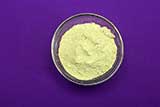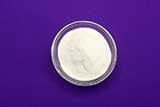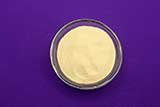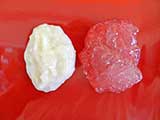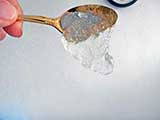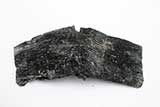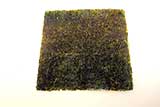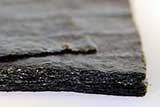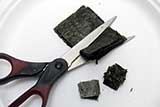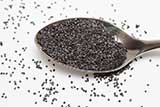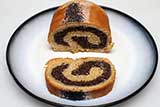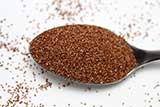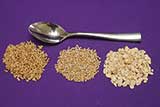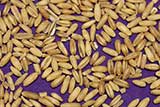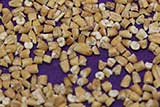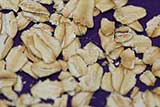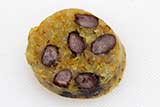Meats and Sausages
Materials and Ingredients
The Importance of Fat
One of the characteristics of fat is that it acts as a flavor intensifier. In addition, fat provides a pleasant mouthfeel which is hard to replace with fat substitutes. People find a low-fat diet bland and have difficulty to maintain it over a period of time. To function properly our body needs fat. It maintains cell membranes, absorbs vitamins, carries food flavors and provides energy. Fats can be classified as:
- Saturated - found mainly in animals (meat and poultry, butter, cheese and milk products). Cocoa butter, coconut oil and palm oil are also highly saturated. Saturated fats are solid at room temperature: lard, butter, suet. Saturated fats are “bad fats.”
- Monounsaturated fat - found in plants, but also in animals. Olive, canola and peanut oil. These are “good fats.”
- Polyunsaturated fat-plants. Corn, olive, canola, peanut, sunflower, soybean, safflower, cotton seed. Also present in fish. These are “good fats.”
Oils
Oils are the fats which are used in vegetarian sausages. They are liquid at room temperature and low in saturated fatty acids. Oils are generally much healthier and contain less saturated acids. The fats in seafood, nuts, and seeds are considered oils.
| Comparative properties of common cooking oils per 1 Tbsp (14g) | ||||
|---|---|---|---|---|
| Total Fat | Saturated Fat | Monounsaturated Fat | Polyunsaturated Fat | |
| Canola | 14 g | 1.0 g | 8.0 g | 4.0 g |
| Corn | 14 g | 2.0 g | 4.0 g | 8.0 g |
| Olive | 14 g | 2.0 g | 10 g | 1.5 g |
| Soy | 14 g | 2.2 g | 3.2 g | 8.0 g |
| Sunflower | 14 g | 1.5 g | 3.0 g | 9.0 g |
| Peanut | 14 g | 2.5 g | 6.0 g | 5.0 g |
All fats, oils included go “rancid” (deterioration of flavor) in time even when frozen, however, in oils the rancidity starts to develop after one year. Adding directly more than 5% oil to a vegetarian sausage can make it oily and greasy, however, larger amounts can be added in the form of emulsion.
Additives used in sausage production can be classified as:
- Extenders and binders. These products extend expensive meat proteins with cheaper plant proteins, like soy proteins. Non-fat dry milk, sodium caseinate (milk protein) and egg white fit into this category too. The main purpose of using meat extenders has been to lower the cost of a product. They are capable of binding water as well. A mixture of three parts water and one part vegetable protein is prepared and this paste can be added to ground meat. A typical proportion: 75% meat, 25% extender. Such an extender can be added to vegan sausages, however, protein-water-oil emulsion is a better choice. The most commonly used extenders are: The above products augment the protein content of the sausage, however, the main reason for their use is their ability to provide binding, emulsifying and extending properties. This improves texture, color and flavor of the sausages.
- Fillers - increase the volume of the sausage. The result is a lower cost yet still nutritive product. Fillers are carbohydrate products able to absorb large quantities of water but they are not good emulsifiers. Fillers are usually added at 2-15%. By using meat extenders and fillers together, the cost of the extended product can be lowered significantly.
- Grains - amaranth, barley, buckwheat, corn, millet, oats, quinoa, rye, rice, sorghum, teff, wheat.
- Roots and Tubers - potatoes, cassava, taro, yams, beets.
- Legumes are among the best protein sources.: beans, peas, lentils, peanuts.
- Emulsions.
- Gums immobilize water and contribute viscosity. This improves texture, sliceability and provides better mouthfeel.
- Binders
Egg white is often added to sausages to increase binding of ingredients. It should be noted that only the egg white possesses binding properties. The egg yolk is a good emulsifier but contributes to more cholesterol and calories.
| Egg (100 g serving) | Protein (g) | Fat (g) | Carbohydrates (g) | Salt (mg) | Energy (cal) | Cholesterol (mg) |
|---|---|---|---|---|---|---|
| Egg Whole, raw | 12.56 | 9.51 | 0.72 | 142 | 143 | 372 |
| Egg White, raw | 10.90 | 0.17 | 0.73 | 166 | 52 | 0 |
| Source: USDA Nutrient database | ||||||
Egg white is often added (1-3%) to frankfurters with low meat content. It increases protein content, forms stable gel and contributes to a firm texture of the sausage. Powdered egg whites are also available and you generally mix 2 teaspoons of powder with 2 tablespoons of water for each white.
| Ingredient (100 g serving) | Protein (g) | Fat (g) | Carbohydrates (g) | Salt (mg) | Energy (cal) |
|---|---|---|---|---|---|
| Egg, white, dried | 81.10 | 0.00 | 7.80 | 1280 | 382 |
| Source: USDA Nutrient database | |||||
Ready to use liquid egg whites that are packaged in convenient size containers are available in supermarkets.
| Ingredient (46 g serving) | Protein (g) | Fat (g) | Carbohydrates (g) | Salt (mg) | Energy (cal) |
|---|---|---|---|---|---|
| Egg, white, liquid | 5 | 0.00 | 0.00 | 75 | 25 |
| Source: Crystal Farms, All Whites | |||||
From Bob's Red Mill:
Egg Replacer: 1 Tbsp Bob’s Red Mill Flaxseed Meal + 3 Tbsp water = 1 egg.
Mix Bob’s Red Mill flaxseed meal and water in a small bowl and let sit for one to two minutes. Add to a recipe as you would an egg. This is a very versatile egg replacement formula.
Non-fat dry milk is produced by removing fat and water from milk. Lactose (milk sugar), milk proteins and milk minerals are present in the same relative proportions as in fresh milk. Dry milk powder greatly improves the taste of low fat sausages. It is added at about 3% and effectively binds water and emulsifies fats. Its action is very similar to that of soy protein concentrate.
| Ingredient (100 g serving) | Protein (g) | Fat (g) | Carbohydrates (g) | Salt (mg) | Energy (cal) |
|---|---|---|---|---|---|
| Non-fat dry milk | 36.16 | 0.77 | 51.98 | 535 | 362 |
| Source: USDA Nutrient database | |||||
Gelatin
Gelatin, technically classified as a hydrocolloid is made from by-products of the meat and leather industry (bones, hides, pig skin). When mixed with water, it forms a semi-solid colloid gel. Gelatin forms a thermoreversible gel - it melts to a liquid when heated and solidifies when cooled again. Gelatin may be used as a stabilizer, or thickener in foods such as jams, yoghurt, cream cheese, and margarine. It is used in fat-reduced foods to mimic the mouthfeel of fat and to increase volume without adding calories. Combining gelatin with various hydrocolloids has resulted in new food additives that closely mimic the mouthfeel of fats.
| Ingredient (100 g serving) | Protein (g) | Fat (g) | Carbohydrates (g) | Salt (mg) | Energy (cal) |
|---|---|---|---|---|---|
| Gelatin, dry powder | 85.60 | 0.10 | 0.00 | 196 | 335 |
| Source: USDA Nutrient database | |||||
Powdered gelatin added at 1-2% helps to bind de-boned meat together or stuffing individual cuts of meat which are not perfectly lean. Gelatin is widely used in meat products for decorative jellies for pates and for the coating and glazing of ham and other cooked meat products giving these products an attractive appearance. Gelatin also improves the slicing characteristics of meats by penetrating and filling any cavities in the meat tissue, especially where the bone has been removed. This bonds individual meat pieces together which is of crucial importance when making molded hams.
Gelatin is also used in the manufacture of canned meat products where it serves to absorb the juices that are released during the retorting process. Gelatin being almost pure protein also enhances the protein balance of the final product. Gelatin is first dispersed in cold water and then completely dissolved in water at 122-140° F (50-60° C). Gelatin is a much more powerful thickener than egg. Gelatin is always used in a ratio to liquids in the recipe: usually 1/4 ounce of powdered gelatin is needed to set 16 ounces of liquid. To obtain a "semi-solid" consistency increase the liquid to 32 ounces. If the ratio is incorrect, the product will be either runny or too firm and rubbery.
Fillers
Beans make a good filler and can act as a showpiece material. Red or black beans will look striking against a background of white protein emulsion. Everybody likes burritos which is ground meat mixed with bean paste. How about chili? Beans can be soaked in water for a few hours then simmered in a little water. The resulting bean paste can be used as a filler.
Bread crumbs are ground and roasted bread particles. They absorb water very well, similarly to rusk. Bread crumbs can absorb water at 2 times their weight.
Barley and buckwheat groats are added to many sausages, for example to Polish blood sausages, however, they are suitable as a filler material for any sausage.
Buckwheat groats are cooked for about 20 minutes in water as follows:
- 1 part raw buckwheat groats to 1.8 part water
- 1 part roasted raw buckwheat groats to 2 parts water
- 1 part barley groats to 2.1 parts of water
Roasted buckwheat groats are much darker in color, have more intense flavor and are less popular for making sausages.
Cracker meal is a type of coarse flour which is made from finely milled crackers. Cracker meal is used for breading meat or fish or topping dishes to be baked or broiled. Cracker meal is similar to bread crumbs, although it is lighter in color and has a milder taste. It can absorb water at 1.5 times its weight.
Dried Wheat Rolls
After World War II ended in Europe people in heavily damages countries like Poland, Russia or Germany could not buy bread crumbs in stores because there were no stores. They would save and dry wheat rolls. Then they would be soaked in water or milk and used as a filler in meat products.
You can save wheat rolls such as Portuguese rolls or French baguettes. They will dry out and will remain usable for a long time. Before use, soak them in water or milk. Then mix with ground meat and other ingredients. Add an egg to combine the mass better.
Flours and Starches
Flours and starches make great fillers, water absorbers and binders. Flours such as corn, potato, wheat, soy and rice are in common use in the Western world. However, there are tubers such as cassava that grow in very hot climates in Africa, South America or the Caribbean region. The Caribbean and the nations with populations of West African origin such as Cuba, the Dominican Republic and Puerto Rico often use mashed plantains or yams which are then combined with other ingredients. Popular products are gari and tufu flour. Flours give the sausages a somewhat firmer structure. In sausages starch is used for its properties to bind water and to improve the texture of the product. The most common sources of starch are potato, wheat, corn, rice and tapioca. You can add as much flour as you like, but around 2-10% is added to meat sausages. Starch is a common additive in extended injected products like a ham. It is usually applied at 1-5% (10-50 g/kg) of a finished product. The amount of flour or starch can be increased in vegetarian sausages.
Bran is an outside beneficial fiber. It accounts for about 14.5% of the kernel weight.
Endosperm is a source of white flour. It accounts for about 83% of the kernel weight.
Germ is the embryo of the seed and accounts for 2.5% of the kernel weight.
Whole grains foods or whole grain flour must contain all three parts of the grain.
White flour is made from endosperm only. To compensate for the nutrients that were in bran and germ but were milled out, new nutrients are mixed with white flour and the product becomes enriched white flour.
Flour is a thickener with half the thickening power of starch. There are many ways to use flour as a thickener – dredge stew meats in flour before browning it and the flour will later thicken the stew when a liquid is added. You can mix flour with a little cool liquid to form a paste and then add it into simmering sauce. One thing we shouldn’t do with flour is throw it directly into hot liquid because the flour particles will clump together. To achieve full thickening power and eliminate raw flour taste, flour-thickened mixtures must be brought to a boil and then cooked for about 3 minutes. There is no need to cook longer because flour thickens more as it cools; as a rule stop cooking gravies and sauces when they’re a bit thinner than their ideal consistency.
| Nutritional Values of Different Flours (100 g serving) | ||||||
|---|---|---|---|---|---|---|
| Name | Protein (g) | Fat (g) | Carbohydrates (g) | Salt (mg) | Fiber (g) | Calories (cal) |
| Soy, full-fat | 34.54 | 20.65 | 35.19 | 13 | 9.6 | 436 |
| Soy, low-fat | 45.51 | 8.90 | 34.93 | 9 | 16.0 | 375 |
| Soy, de-fatted | 47.01 | 1.22 | 38.37 | 20 | 17.5 | 330 |
| Wheat, whole grain | 13.21 | 2.50 | 71.97 | 2 | 10.7 | 340 |
| Wheat, white | 10.33 | 0.98 | 76.31 | 2 | 2.7 | 364 |
| Potato | 6.90 | 0.34 | 83.10 | 55 | 5.9 | 357 |
| Rice, white | 5.95 | 1.42 | 80.13 | 0 | 2.4 | 366 |
| Corn, whole grain, white | 6.93 | 3.86 | 76.85 | 5 | 7.3 | 361 |
| Semolina | 12.68 | 1.05 | 72.83 | 1 | 3.9 | 360 |
| Chickpea (besan) | 22.39 | 6.69 | 57.82 | 64 | 10.8 | 387 |
| Source: USDA Nutrient database | ||||||
Corn flour, (maize, corn meal) contributes to good slicing characteristics. Corn flour comes in yellow and white and is used for breading and in combination with other flours in baked goods White corn flour blends well with other food ingredients and can be blended with wheat flour.
Gram flour is a flour made from ground chickpeas. It is also known as chickpea flour, garbanzo flour, or besan. In comparison to other common flours such as wheat, potato, rice, corn, and semolina, it has a relatively high proportion of protein. Used in many countries, it is a staple ingredient in Indian, Pakistani and Bangladeshi cuisines, and in the form of a paste with water or yoghurt. Moreover, when mixed with an equal proportion of water it can be used as an egg-replacer in vegan cooking. Chila (or chilla), a pancake made with gram flour batter is a popular street and fast food in India.
Green pea flour is made by grinding green peas. High in protein and fiber, it is an excellent addition to baked goods, soups, sauces and dips.
Polenta is cornmeal made into a porridge by cooking ground yellow corn. The term is of Italian origin, however, it can be found all over the world in the form of maize porridge. Polenta has a creamy texture due to the gelatinization of starch in the grain. It can be ground coarsely or finely depending on the texture desired, however, creamier polenta is produced with a fine grind. Polenta was originally classified as a peasant food, after all, it is ground corn. In recent years polenta has found popularity as a gourmet food. Many current polenta recipes enrich polenta with meat and mushroom sauces, and add vegetables, beans or various cheeses into the basic mixture. Not surprisingly, polenta can be used with great success in vegetarian sausages.
Polenta takes a long time to cook, typically simmering in four to five times its volume in water for about 45 minutes with almost constant stirring needed for even gelatinization of the starch. Cooked polenta must be thick enough to be shaped into balls, patties, or sticks, and then fried in oil, baked, or grilled until golden brown. Polenta porridge can be eaten with milk for breakfast.
Potato flour is the preferred flour for making meat sausages. Many Russian sausages include around 2-3% of potato flour in their composition. It made sausages cheaper and improved the mouthfeel of low fat products. Potato flour binds water well and has flavor that agrees quite well with reduced-fat sausages improving their texture and mouthfeel. It is a good filler for vegetarian sausages.
Rice flour is made milling white or brown rice. Rice flour may be used as a thickening agent in recipes that are refrigerated or frozen since it inhibits liquid separation. It is a good substitute for wheat flour.
Semolina is made during the grinding of harder durum wheat to make flour. Healthy high caloric food (325 cal per 100 g) semolina was often given with milk and sugar to children for breakfast. Semolina is used in making pasta, breakfast cereals, puddings, bread crust and general baking.
Durum wheat is considered the top choice for making paste; the wheat kernel’s density and high protein and gluten content result in firm pasta with a consistent cooking quality and golden color. In sausages it is used to bind ingredients together. Semolina contributes to a stronger binding and has been used as a filler in many European sausages, for example Polish Semolina Liver Sausage, Jowl Sausage and Blood Head Cheese.
Soy flour. All flours can be used for making vegetarian sausages, although soy flour may impart a “beany taste” to the product.
Tapioca starch and tapioca flour are the same thing. Tapioca is a pure starch derived from the root of the cassava plant and it comes in many forms. The small granules of pearl tapioca are widely available and work well as a thickener. Tapioca gel is crystal clear and has a strong jelly-like consistency.
Wheat flour is made from the grinding of wheat. More wheat flour is produced than any other flour and there are specialized flours for cake, bread and pasta making. General purpose flour is the most popular type.
In addition to typical flours that we are accustomed to, there is a great variety of flours that are utilized in tropical countries, for example African gari and tufu flours are made from yam or cassava flour is made from cassava (yuca). They can be easily obtained online.
Starch and Starch Derived Products
Starch is made by most plants for use as an energy. Ready to eat foods containing starch are bread, pancakes, cereals, noodles, pasta, porridge and tortilla. All starches are good thickeners and are used to thicken soups or gravies. In general baking, especially in pastry filling starch plays an important role as it is such a strong gelling agent. Starch has the ability to swell and take on water. Varying the ratio of starch to water will change its properties. The swelling of the starch occurs during the heating stage. As a starch paste cools a gel is formed. All starches begin to thicken at around 140° F (60° C). However, to achieve full thickening power, cereal flour and starch which have a high percentage of a starch molecule called amylose must come all the way to a boil and be held just below the boiling point for several minutes to cook off the raw starch flavor. Potato starch thickens quickly without a pronounced flavor that needs to be cooked off which makes it great as a last minute fix for too-thin sauces. Its ability to gel below water boiling temperature made it popular with meat sausages. Adding starch directly into the cooking food will form lumps that are then difficult to dissolve. To avoid lumps mix the starch with an equal amount of cold liquid until it forms a paste, then whisk it into the liquid to thicken it. Starch is made of two main components:
- Amylose.
- Amylopectin – contributes towards a strong, translucent, stringy gel.
When water is added and it is heated some of the bonds between the amylase and amylopectin molecules break and the starch undergoes "gelatinization," which means it becomes gel. The properties of starch (and gel) depend on the ratio of amylase and amylopectin.
Starch comes from:
- Roots/tubers – potato, arrowroot, tapioca. Roots/tubers contain about 80% amylopectin.
- Cereal – corn, wheat, rice. Cereals contain about 75%, however, rice contains almost all amylopectin and very little amylase.
| Starches | ||
|---|---|---|
| Roots/Tubers | Arrow-root | Rich in amylopectin, thicken well before the boiling point, makes a clear gel. |
| Tapioca | Rich in amylopectin, thickens well before the boiling point. Makes clean gel, freezes well. Tapioca starch and tapioca flour are the same thing. | |
| Potato | Rich in amylopectin, best thickening ability. Sets at relatively low temperature, does not need to go into a boil. It produces very clear gel, softer than corn starch. | |
| Cereals | Corn | Corn starch contains less amylopectin than potato starch so it is a less effective thickening agent than potato starch, however, it produces a strong gel. It must be heated to higher temperatures than potato starch. |
| Rice | Rice starch has the smallest particle size of all starches making it very absorbent. It has a very clean taste and doesn't interfere with other flavors. Rice starch is often used in baby formulas. | |
| Wheat | Worst thickening ability. It thickens at boiling temperature and must be thoroughly cooked. | |
Cornstarch is derived from corn. It can withstand a good amount of cooking and stirring before it begins to break down. That’s why it’s frequently used for thickening pastry products which are baked or foods which are cooked on the stove and involve prolonged heating and stirring. Cornstarch has twice the thickening power of flour, but like flour it imparts a slightly starchy taste which disappears after a few minutes of high heating. Another advantage is that unlike flour-thickened sauces it doesn’t separate when frozen.
Arrowroot starch comes from the root of a tropical plant of the same name. Look for it in gourmet or health-food stores. Arrowroot starch granules are very small and make sauces exceptionally smooth. Like flour and cornstarch it can withstand long cooking and higher temperatures, and like tapioca it is remarkable for its clarity. It’s a great choice for stir-fry sauces and any kind of fruit pie filling.
In food applications a starch is twice as effective as the flour it was made from.
| Flour | Equivalent Amount of Starch | |||
| Corn | Tapioca | Arrowroot | Potato | |
| 2 Tbsp | 1 Tbsp | 1 Tbsp | 1 Tbsp plus 1-1/2 tsp | 1-1/2 tsp |
Potato starch is most commonly called for in European recipes. It’s easy to find in the baking ingredient aisle of East Coast markets, but in the rest of the country look for it in the kosher section of the store. Potato starch is 100 percent starch whereas potato flour is about 85 percent starch, the rest being largely fiber, protein, fat, and sugar. Potato starch is pure white, while potato flour is yellowish having traces of color and flavor from the potato. Potato starch turns clear while potato flour turns opaque. To extract the starch the potatoes are crushed and the starch grains are released from the mashed potatoes. The starch is then washed out and dried to powder. The superior water binding of potato starches improves moisture retention and increases yield while providing juiciness in processed meats.
Potato Starch
Potato Flour
Unmodified potato starch gelatinizes at 147° F (64° C) which is below the recommended meat internal temperature for cooked food so a strong gel is always assured. Other starches gelatinize at temperatures from 165° F (73° C) to 178° F (81° C).
| 100 g Serving | Protein (g) | Fat (g) | Carbohydrates (g) | Salt (mg) | Energy (cal) | Cholesterol (mg) |
|---|---|---|---|---|---|---|
| Potato flour | 8.82 | 1.47 | 79.4 | 0 | 353 | 0 |
| Potato starch | 0 | 0 | 83.3 | 0 | 333 | 0 |
| Source: Bob’s Red Mill Natural Foods | ||||||
What is Better for Sausages – the Flour or the Starch?
All starches begin to thicken at around 140° F (60° C). But to achieve full thickening power flour cereal starches (corn, rice, wheat) need to be heated to 212° F (100° C) which makes them less suited for making sausages. Meat sausages, liver, blood or head cheese, whether smoked are usually boiled in water at 176° F (80° C) until the meat reaches around 160° F (72° C) temperature inside. If the temperature is higher, the fat melts, the texture and quality suffers and the sausage is greasy on the outside. Potato starch is a root starch and root starches gel below the boiling point (212° F, 100° C). Many Russian and Polish sausages included around 2% potato flour in their composition. Not wheat, rye, corn or rice flour, but the potato flour. Swedish sausages are made with potatoes and they are delicious. Well, if potato flour and potato starch are so suitable for meat sausages, they should work well in vegetarian sausages as well.
It takes twice as much flour as starch to create a gel. Take for example tofu which is soft and contains plenty of water. Using too much tofu will make your sausage very soft. Adding starch or gum will bind some water, but the resulting gel will be soft as well. However, more flour is needed than starch to bind water so the sausage will be much firmer. Gelled flour produces an opaque paste unlike a clear gel made from starch. If you want to create a white sausage with clearly visible ingredients such as cranberries or pistachios, it may be better to use a starch. If the color is less important, flour is a better filler material.
A combination of starch and gum produces a synergistic effect:
- starch and carrageenan.
- 1 part potato starch and 2 parts of guar gum.
- 1 part potato flour and 3 parts guar gum.
For making sausages potato flour is the best choice as it has a great flavor, gels at low temperature and does not contain gluten, a fact to consider by people allergic to it.
Rusk is a popular filler in England. It is made from wheat flour mixed with water, baked and crushed. It can be ground to different diameters and there is a coarse, medium or fine rusk. It is a good binder and can absorb water at 3 - 4 times its weight.
Textured Vegetable Protein (TVP) is a great filler.
Vital wheat gluten is all gluten and very little starch. It is is made from the protein found in the endosperm of the wheat berry, containing 75% to 80% protein by hydrating the flour to activate the gluten and then processed to remove everything but that gluten.
It is then dried and ground back into a powder. It is responsible for the stretchiness of dough and for the shapes that baked goods hold. Most baking sources recommend about one tablespoon for every 2-3 cups of flour.
| Vital wheat gluten, 100 g serving | |||||
|---|---|---|---|---|---|
| Protein (g) | Fat (g) | Carbohydrates (g) | Salt (mg) | Energy (cal) | Cholesterol |
| 55.5 | 0 | 33.3 | 0 | 388 | 0 |
| Source: Arrowhead Mills | |||||
Vital wheat gluten is also a staple ingredient for meat and meat substitutes. It acts as a binder for meatballs, meatloaf, veggie burgers and tofu alike. When the gluten dough is cooked, it becomes chewy with a meat-like texture, however, it has a very rubbery feel. In our trials we have obtained much better results making wheat gluten from whole wheat flour, although the process is more labor intensive. However, vital wheat gluten is a wonderful binder for many grains and other fillers like for example bread crumbs.
Fillers (Meat Substitutes)
The following soy materials can be considered main fillers, however, they are usually described as meat substitutes:
We feel hesitant to call soy derived products "meat substitutes or analogues" because they cannot mimic the flavor of the meat so such a definition is wishful at best. It is better to break with the notion that vegetarian sausages should duplicate the flavor of meat sausages and think of them rather as a different type of sausage. A meat sausage is a meat sausage and a vegetarian sausage is a vegetarian sausage, two different products like apples and oranges. By accepting this fact we can remove the preconceived notion of how the sausage should be made, look or taste and free our imagination to create original vegetarian sausages.
Tofu - is the best known meat substitute, however, it does not really have a "meaty" texture, like wheat gluten or textured vegetable protein. Tofu is described in Chapter 3.
Seaweeds
Dry seaweed and pressed seaweed sheets known as "nori" can be soaked in water/broth to create a fishy flavor for vegetarian fish sausages.
Legumes, Grains and Seeds
Grains are wonderful and nutritional fillers. They are very healthy with a high protein content and plenty of fiber which we do not eat enough, a well known fact. It may come as a surprise but the protein content of most grains equals that of lean meat. Seeds and nuts for example peanuts, soy beans and chick pea flour contain more protein than meat.
Grains are available as whole, cut or flour. You can use whole grains, however, the cooking process will be much shorter if they are cut into smaller parts. For example it is easier to work with steel cut oats than whole grains. Wheat comes as whole grain, steel cut and flour which comes in different varieties and colors. Smaller grains like buckwheat or millet are best used as whole. Certain grains are flattened, for example, rolled oats which we know as instant oats. For visual effects you may want whole grain wheat or rice in your recipe which is fine as long as you bind the ingredients properly so they stick together.
| Name (The weight of grain=100 g) | Protein (g) | Fat (g) | Carbohydrates (g) | Fiber (g) | Calories |
|---|---|---|---|---|---|
| Amaranth, grain, uncooked | 13.56 | 7.02 | 65.25 | 3.7 | 371 |
| Barley, pearled, raw | 9.91 | 1.16 | 77.72 | 15.6 | 352 |
| Beans, black, raw | 21.60 | 1.42 | 62.36 | 15.5 | 341 |
| Beans, kidney, red, raw | 22.53 | 1.06 | 61.29 | 15.2 | 337 |
| Beans, white, raw | 23.36 | 0.85 | 60.27 | 15.2 | 333 |
| Buckwheat | 13.25 | 3.40 | 71.50 | 10.0 | 343 |
| Chickpeas (Garbanzo) | 20.47 | 6.04 | 62.95 | 12.2 | 378 |
| Corn, fried, yellow | 14.48 | 10.64 | 66.27 | 20.05 | 419 |
| Flaxseed | 28.88 | 42.16 | 28.88 | 27.3 | 534 |
| Lentils, raw | 24.63 | 1.06 | 63.35 | 10.07 | 352 |
| Millet, raw | 11.02 | 4.22 | 72.85 | 8.5 | 378 |
| Oats, cereals, dry | 13.15 | 6.52 | 67.70 | 10.1 | 379 |
| Peas, green, split, raw | 23.82 | 1.16 | 63.74 | 25.5 | 352 |
| Poppy seed | 17.99 | 41.56 | 28.13 | 19.5 | 525 |
| Quinoa, uncooked | 14.12 | 6.07 | 64.16 | 3.0 | 368 |
| Rice, white, raw | 6.50 | 0.52 | 79.15 | 2.8 | 358 |
| Soybeans, raw | 36.49 | 19.94 | 30.16 | 9.3 | 446 |
| Sorghum grain | 10.62 | 3.46 | 72.09 | 6.7 | 329 |
| Teff, uncooked | 13.30 | 2.38 | 73.13 | 8.0 | 367 |
| Wheat, hard, white | 11.31 | 1.71 | 75.90 | 12.2 | 342 |
| Source: US National Nutrient Database. For more detailed analysis go to: http://ndb.nal.usda.gov/ndb/search | |||||
Poppy seeds are very small and are added whole to pastry products like bagels, however, for best results they should be ground with a seed grinder to release oil and flavor components. Whole poppy seeds are a familiar topping on a bagel, but ground poppy seeds are used in pastry, for example in Polish rolled cake known as "makowiec."
Oats
Oats have numerous uses in foods; most commonly, they are rolled or crushed into oatmeal, or ground into fine oat flour. Oatmeal is chiefly eaten as porridge, but may also be used in baked goods. When cooked they develop a sticky gel which binds other ingredients.
Whole grains are seldom used unless as feed for horses. Yes horses know good food and they absolutely love oats.
Steel cut oats are simply whole oat groats that have been cut into neat little pieces on a steel buhr mill which makes them faster to cook when making porridge. Also known as Irish oats or pinhead oats, steel cut oats create a chewy full-bodied hot cereal.
Steel cut oats are the best choice for sausages as they develop a familiar chewy texture which feels like ground meat.
Instant oats are most popular as they are easy to prepare. They are called rolled oats because rotating steel drums flatten them out.
Show Material
Making each sausage in the form of a hot dog can be considered very rudimentary sausage making. Anybody can throw a bunch of ingredients into a food processor and stuff the paste into a sausage casing.
Well how about making a large diameter white looking sausage with pistachios, cranberries, raisins or prunes inside. Textured vegetable protein are irregular soy protein nuggets which not only look attractive but possess the bite and flavor of meat pieces. Showpiece material stands out and makes the sausage looking pretty. Diced tofu stands out well against darker materials.
Typical Usage Amounts of Common Additives
Flavor Enhancers
MSG (monosodium glutamate) is a flavor enhancer that is produced by the fermentation of starch, sugar beets, sugar cane, or molasses. Although once stereotypically associated with foods in Chinese restaurants, it is now found in many common food items, particularly processed foods. MSG is commonly available in food stores.
Ribonucleotide is a much stronger flavor enhancer than MSG and is carried by commercial producers.
Liquid smoke can be added to vegetarian sausages to obtain a smoky flavor.
Sesame seeds, especially the oil carry a unique slightly smoky flavor.
| Name | Common amount |
|---|---|
| Soy protein concentrate | 1-3% |
| Soy protein isolate | 1-3% |
| Non-fat dry milk | 1-3% |
| Milk caseinate | 2% |
| Whey protein concentrate | 1-3% |
| Whey protein isolate | 1-3% |
| Agar | 0.2-3.0% |
| Alginate | 0.5-1% |
| Carrageenan-Kappa | 0.02-1.5% |
| Konjac | 0.25-0.50% |
| Xanthan | 0.02-0.03% |
| Locust bean gum (LBG) | 0.1-1.0% |
| Gellan | 0.4-0.7% |
| Guar gum | 0.1-0.7% |
| Gum Arabic | 10-90% |
| Low methoxy pectin (LM Pectin) | 0.5-3.0% |
| Gelatin | 0.5-2.0% |
| Textured vegetable protein (TVP) | 0.1-15% |
| Starch | 1-5% |
| Oil | 1-5% |
| Monosodium glutamate | 0.2-1.0% |
Summary of Important Issues
- Finely cut fillers such as flours and starches are usually added dry.
- Coarse fillers such as bread crumbs, rusk, cereals and TVP are usually re-hydrated before adding them to a mix.
- Don’t add salt to cooking water when preparing rice, potatoes, barley or making meat stock. Salt will be added during mixing ingredients.
- Soy protein concentrate (or isolate) binds water and retains moisture during cooking. The sausage will look plumper.
- Non-fat dry milk binds water well.
- White of an egg binds all ingredients well together, but gelatin is stronger.
- Using prepared protein emulsion produces not only better sausages but makes the process simpler and faster.
- Adding 1% of powdered gelatin greatly improves texture of sausages, however, gelatin is made from pork skins.
Coconut Milk
Coconut milk can be used in many recipes.
| Ingredient (100 g serving) | Protein (g) | Fat (g) | Carbohydrates (g) | Salt (mg) | Energy (cal) |
|---|---|---|---|---|---|
| Canned coconut milk | 2.02 | 21.33 | 2.81 | 13 | 197 |
| Source: USDA Nutrient database | |||||
Vegetarian sausage recipes are listed in the Sausage Recipe Index.


